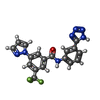[English] 日本語
 Yorodumi
Yorodumi- PDB-7s0v: The role of an Asp-Asp pair in the structure, function and inhibi... -
+ Open data
Open data
- Basic information
Basic information
| Entry | Database: PDB / ID: 7s0v | ||||||
|---|---|---|---|---|---|---|---|
| Title | The role of an Asp-Asp pair in the structure, function and inhibition of CTX-M Class A Beta-lactamase | ||||||
 Components Components | Beta-lactamase | ||||||
 Keywords Keywords | HYDROLASE/HYDROLASE inhibitor / Inhibitor / Complex / Asp-Asp / HYDROLASE / HYDROLASE-HYDROLASE inhibitor complex | ||||||
| Function / homology |  Function and homology information Function and homology informationbeta-lactam antibiotic catabolic process / beta-lactamase activity / beta-lactamase / response to antibiotic / metal ion binding Similarity search - Function | ||||||
| Biological species |  | ||||||
| Method |  X-RAY DIFFRACTION / X-RAY DIFFRACTION /  SYNCHROTRON / SYNCHROTRON /  SAD / Resolution: 1.95 Å SAD / Resolution: 1.95 Å | ||||||
 Authors Authors | Kemp, M.T. / Chen, Y. | ||||||
| Funding support |  United States, 1items United States, 1items
| ||||||
 Citation Citation |  Journal: Febs Lett. / Year: 2021 Journal: Febs Lett. / Year: 2021Title: Mutation of the conserved Asp-Asp pair impairs the structure, function, and inhibition of CTX-M Class A beta-lactamase. Authors: Kemp, M.T. / Nichols, D.A. / Zhang, X. / Defrees, K. / Na, I. / Renslo, A.R. / Chen, Y. | ||||||
| History |
|
- Structure visualization
Structure visualization
| Structure viewer | Molecule:  Molmil Molmil Jmol/JSmol Jmol/JSmol |
|---|
- Downloads & links
Downloads & links
- Download
Download
| PDBx/mmCIF format |  7s0v.cif.gz 7s0v.cif.gz | 111.1 KB | Display |  PDBx/mmCIF format PDBx/mmCIF format |
|---|---|---|---|---|
| PDB format |  pdb7s0v.ent.gz pdb7s0v.ent.gz | 84 KB | Display |  PDB format PDB format |
| PDBx/mmJSON format |  7s0v.json.gz 7s0v.json.gz | Tree view |  PDBx/mmJSON format PDBx/mmJSON format | |
| Others |  Other downloads Other downloads |
-Validation report
| Summary document |  7s0v_validation.pdf.gz 7s0v_validation.pdf.gz | 707 KB | Display |  wwPDB validaton report wwPDB validaton report |
|---|---|---|---|---|
| Full document |  7s0v_full_validation.pdf.gz 7s0v_full_validation.pdf.gz | 710.2 KB | Display | |
| Data in XML |  7s0v_validation.xml.gz 7s0v_validation.xml.gz | 14.4 KB | Display | |
| Data in CIF |  7s0v_validation.cif.gz 7s0v_validation.cif.gz | 21.1 KB | Display | |
| Arichive directory |  https://data.pdbj.org/pub/pdb/validation_reports/s0/7s0v https://data.pdbj.org/pub/pdb/validation_reports/s0/7s0v ftp://data.pdbj.org/pub/pdb/validation_reports/s0/7s0v ftp://data.pdbj.org/pub/pdb/validation_reports/s0/7s0v | HTTPS FTP |
-Related structure data
| Similar structure data |
|---|
- Links
Links
- Assembly
Assembly
| Deposited unit | 
| ||||||||
|---|---|---|---|---|---|---|---|---|---|
| 1 |
| ||||||||
| Unit cell |
| ||||||||
| Components on special symmetry positions |
|
- Components
Components
| #1: Protein | Mass: 27999.561 Da / Num. of mol.: 1 Source method: isolated from a genetically manipulated source Source: (gene. exp.)  Gene: blaCTX-M-14, beta-lactamase CTX-M-14, bla, bla CTX-M-14, bla-CTX-M-14a, blaCTX-M, blaCTX-M-14a, blaCTX-M-14b, blaCTX-M-14c, blaCTX-M-27b, blatoho-3, blaUOE-2, CTX-M-14 Production host:  References: UniProt: Q9L5C7, beta-lactamase |
|---|---|
| #2: Chemical | ChemComp-J1X / |
| #3: Water | ChemComp-HOH / |
| Has ligand of interest | Y |
-Experimental details
-Experiment
| Experiment | Method:  X-RAY DIFFRACTION / Number of used crystals: 1 X-RAY DIFFRACTION / Number of used crystals: 1 |
|---|
- Sample preparation
Sample preparation
| Crystal | Density Matthews: 2.06 Å3/Da / Density % sol: 40.41 % |
|---|---|
| Crystal grow | Temperature: 293 K / Method: vapor diffusion, sitting drop / pH: 7.9 / Details: 1M KP1 pH 7.9 / PH range: 7.0-8.3 |
-Data collection
| Diffraction | Mean temperature: 100 K / Serial crystal experiment: N | |||||||||||||||||||||||||||||||||||||||||||||||||||||||||||||||||||||||||||||||||||||||||||||||||||||||||||||||||||||||||
|---|---|---|---|---|---|---|---|---|---|---|---|---|---|---|---|---|---|---|---|---|---|---|---|---|---|---|---|---|---|---|---|---|---|---|---|---|---|---|---|---|---|---|---|---|---|---|---|---|---|---|---|---|---|---|---|---|---|---|---|---|---|---|---|---|---|---|---|---|---|---|---|---|---|---|---|---|---|---|---|---|---|---|---|---|---|---|---|---|---|---|---|---|---|---|---|---|---|---|---|---|---|---|---|---|---|---|---|---|---|---|---|---|---|---|---|---|---|---|---|---|---|---|
| Diffraction source | Source:  SYNCHROTRON / Site: SYNCHROTRON / Site:  APS APS  / Beamline: 22-BM / Wavelength: 1 Å / Beamline: 22-BM / Wavelength: 1 Å | |||||||||||||||||||||||||||||||||||||||||||||||||||||||||||||||||||||||||||||||||||||||||||||||||||||||||||||||||||||||||
| Detector | Type: MARMOSAIC 225 mm CCD / Detector: CCD / Date: Dec 2, 2020 | |||||||||||||||||||||||||||||||||||||||||||||||||||||||||||||||||||||||||||||||||||||||||||||||||||||||||||||||||||||||||
| Radiation | Protocol: SINGLE WAVELENGTH / Monochromatic (M) / Laue (L): M / Scattering type: x-ray | |||||||||||||||||||||||||||||||||||||||||||||||||||||||||||||||||||||||||||||||||||||||||||||||||||||||||||||||||||||||||
| Radiation wavelength | Wavelength: 1 Å / Relative weight: 1 | |||||||||||||||||||||||||||||||||||||||||||||||||||||||||||||||||||||||||||||||||||||||||||||||||||||||||||||||||||||||||
| Reflection | Resolution: 1.95→38.53 Å / Num. obs: 17809 / % possible obs: 98.8 % / Redundancy: 6.6 % / Rpim(I) all: 0.022 / Rrim(I) all: 0.058 / Rsym value: 0.054 / Net I/av σ(I): 7.6 / Net I/σ(I): 23.7 | |||||||||||||||||||||||||||||||||||||||||||||||||||||||||||||||||||||||||||||||||||||||||||||||||||||||||||||||||||||||||
| Reflection shell | Diffraction-ID: 1
|
- Processing
Processing
| Software |
| ||||||||||||||||||||||||||||||||||||||||||||||||||||||||||||||||||||||||||||||||||||||||||||||||||
|---|---|---|---|---|---|---|---|---|---|---|---|---|---|---|---|---|---|---|---|---|---|---|---|---|---|---|---|---|---|---|---|---|---|---|---|---|---|---|---|---|---|---|---|---|---|---|---|---|---|---|---|---|---|---|---|---|---|---|---|---|---|---|---|---|---|---|---|---|---|---|---|---|---|---|---|---|---|---|---|---|---|---|---|---|---|---|---|---|---|---|---|---|---|---|---|---|---|---|---|
| Refinement | Method to determine structure:  SAD / Resolution: 1.95→38.527 Å / SU ML: 0.21 / Cross valid method: THROUGHOUT / σ(F): 1.48 / Phase error: 24.33 / Stereochemistry target values: ML SAD / Resolution: 1.95→38.527 Å / SU ML: 0.21 / Cross valid method: THROUGHOUT / σ(F): 1.48 / Phase error: 24.33 / Stereochemistry target values: ML
| ||||||||||||||||||||||||||||||||||||||||||||||||||||||||||||||||||||||||||||||||||||||||||||||||||
| Solvent computation | Shrinkage radii: 0.9 Å / VDW probe radii: 1.11 Å / Solvent model: FLAT BULK SOLVENT MODEL | ||||||||||||||||||||||||||||||||||||||||||||||||||||||||||||||||||||||||||||||||||||||||||||||||||
| Displacement parameters | Biso max: 114.1 Å2 / Biso mean: 21.1873 Å2 / Biso min: 3.24 Å2 | ||||||||||||||||||||||||||||||||||||||||||||||||||||||||||||||||||||||||||||||||||||||||||||||||||
| Refinement step | Cycle: final / Resolution: 1.95→38.527 Å
| ||||||||||||||||||||||||||||||||||||||||||||||||||||||||||||||||||||||||||||||||||||||||||||||||||
| LS refinement shell | Refine-ID: X-RAY DIFFRACTION / Rfactor Rfree error: 0 / Total num. of bins used: 13
|
 Movie
Movie Controller
Controller



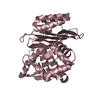
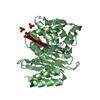
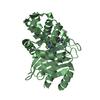
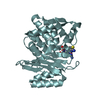
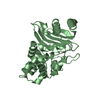

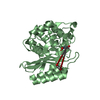
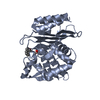
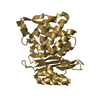
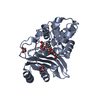






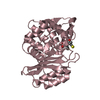

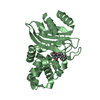
 PDBj
PDBj



